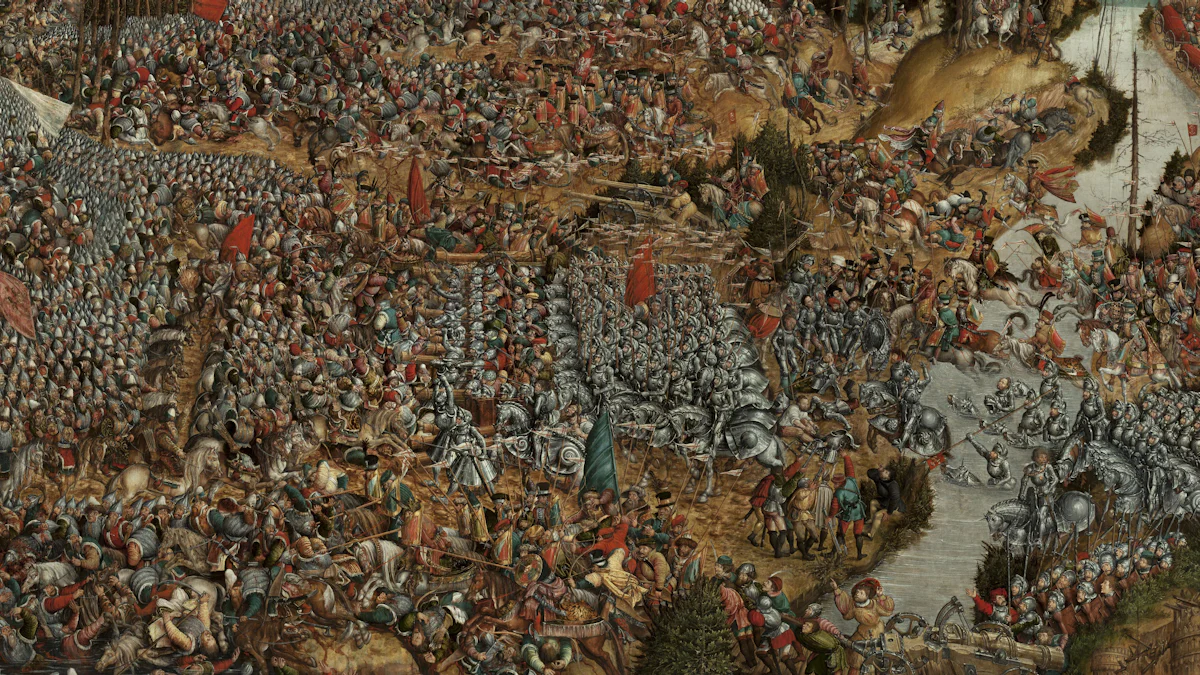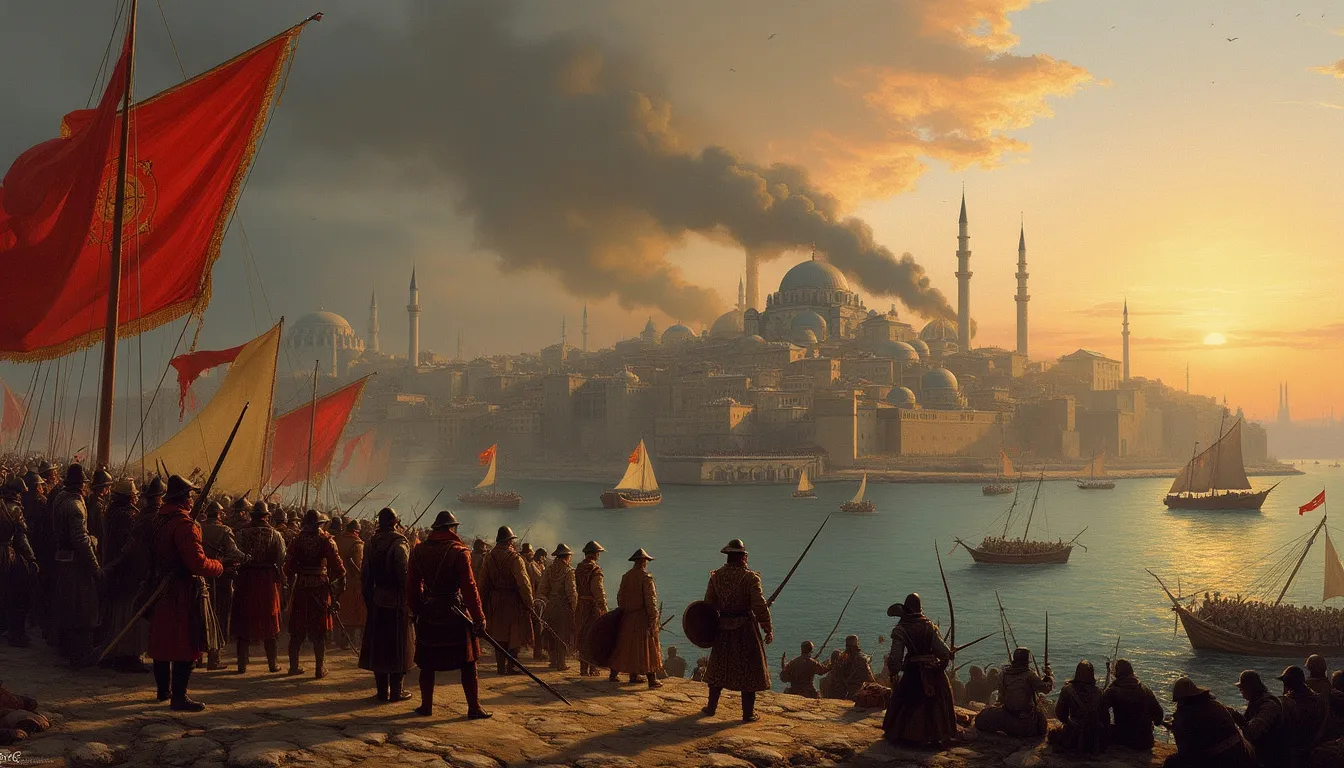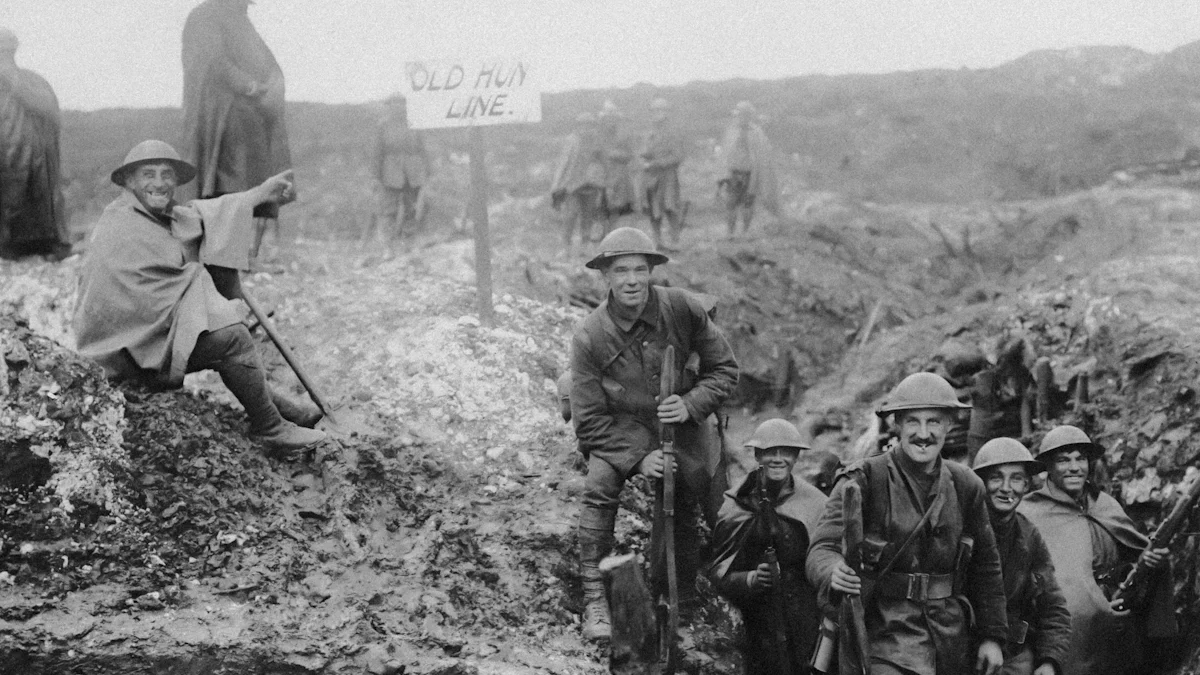Battles that Changed History

Throughout history, battles have been pivotal in shaping the course of global events. These significant moments often determined the fate of empires and nations. The Battle of Gaixia was a crucial turning point in Chinese history, where Liu Bang swiftly rose to power by defeating the Chu fighters. His strategic maneuvers led to a decisive victory. Similarly, the capture of Atahualpa by the Spanish marked a dramatic shift in American history. Liu Bang's triumph brought stability to China, much like the Battle of Muye influenced ancient Chinese dynasties. Understanding these battles provides insights into how leaders like Liu Bang and Atahualpa have influenced history.
Ancient Battles

Battle of Marathon
Overview
The Battle of Marathon occurred in 490 BCE. This battle marked a significant moment in the Greco-Persian Wars. The Persian Empire sought to expand its influence over Greece. Athenian forces, though outnumbered, faced the Persians with courage and strategy.
Key Events
Athenian soldiers, led by General Miltiades, positioned themselves strategically. The Greeks used the terrain to their advantage. The Persian forces underestimated the Greek resolve. The Athenians launched a surprise attack, catching the Persians off guard. This decisive move led to a remarkable victory for Athens.
Implications
The victory at Marathon boosted Greek morale. It demonstrated the effectiveness of hoplite warfare. The battle also preserved Greek independence from Persian control. This triumph inspired future generations and became a symbol of resistance against tyranny.
Battle of Thermopylae
Overview
The Battle of Thermopylae took place in 480 BCE. King Leonidas of Sparta led a small Greek force against the vast Persian army. The narrow pass at Thermopylae served as the battleground. This battle became legendary for the bravery displayed by the Greek soldiers.
Key Events
Leonidas and his 300 Spartans held the pass for several days. Greek forces fought valiantly against overwhelming odds. Persian forces eventually outflanked the Greeks. Despite the defeat, the stand at Thermopylae delayed the Persian advance.
Implications
The battle exemplified heroism and sacrifice. It provided time for Greek city-states to unite. The stand at Thermopylae inspired future resistance against invaders. This battle remains a testament to courage in the face of adversity.
Battle of Gaugamela
Overview
The Battle of Gaugamela, also known as the Battle of Arbela, occurred in 331 BCE. Alexander the Great led his Macedonian army against the Persian Empire. This battle marked a turning point in Alexander's campaign.
Key Events
Alexander employed innovative tactics. His forces executed a daring maneuver to break the Persian lines. The Macedonian phalanx proved effective against the Persian cavalry. Alexander's leadership secured a decisive victory.
Implications
The victory at Gaugamela led to the fall of the Persian Empire. Alexander's conquest expanded his empire significantly. This battle changed the course of history, influencing cultures across the region. The success at Gaugamela solidified Alexander's legacy as a military genius.
Medieval Battles
Battle of Hastings
Overview
The Battle of Hastings occurred in 1066. This battle marked a pivotal moment in the history of England. William the Conqueror led Norman forces against the English army. The death of Edward the Confessor left the English throne contested. William claimed the throne, leading to this decisive battle.
Key Events
Norman forces faced the English army on the battlefield. William's troops used cavalry and archers effectively. The English relied on infantry and shield walls. A feigned retreat by Norman forces broke the English lines. William's strategy led to a Norman victory.
Implications
The victory at Hastings resulted in the Norman conquest of England. William became the first Norman king of England. This battle changed the cultural and political landscape of the country. The Norman influence reshaped English society and governance.
Siege of Constantinople

Overview
The Siege of Constantinople stands as a significant event in medieval history. The city served as the capital of the Byzantine Empire. Various forces attempted to capture this strategic location. The city's formidable defenses included massive walls and a powerful navy.
Key Events
The Ottoman Empire launched a major assault on Constantinople. Sultan Mehmed II led the Ottoman forces. Cannons breached the city's walls after weeks of bombardment. The defenders fought valiantly but faced overwhelming odds. The fall of Constantinople marked the end of the Byzantine Empire.
Implications
The capture of Constantinople by the Ottomans altered the balance of power in Europe. The city became the new capital of the Ottoman Empire. This event marked the end of the Middle Ages and the beginning of the Renaissance. Constantinople's fall opened new trade routes and shifted economic power.
Early Modern Battles
Battle of Lepanto
Overview
The Battle of Lepanto occurred in 1571. This naval battle involved the Holy League and the Ottoman Empire. The Holy League consisted of a coalition of European states, including Spain and Venice. The Ottoman Empire sought to expand its influence across the Mediterranean Sea.
Key Events
The Holy League assembled a formidable fleet. The coalition's ships engaged the Ottoman navy near the Gulf of Patras. The battle saw intense fighting between galleys. The Holy League's superior tactics and artillery led to a decisive victory. The Ottoman fleet suffered heavy losses.
Implications
The victory at Lepanto halted Ottoman expansion in the Mediterranean. The battle marked a turning point in naval warfare. The Holy League's success boosted morale across Christian Europe. The battle demonstrated the importance of coalition forces in military history.
Battle of Blenheim
Overview
The Battle of Blenheim took place in 1704. This battle formed part of the War of the Spanish Succession. The conflict involved the Grand Alliance against France and Bavaria. The British Duke of Marlborough led the allied forces.
Key Events
The allied forces launched a surprise attack on the French and Bavarian troops. The British infantry played a crucial role in breaking enemy lines. The battle featured coordinated assaults by cavalry and infantry. The allies achieved a significant victory, capturing thousands of enemy soldiers.
Implications
The victory at Blenheim shifted the balance of power in Europe. The battle weakened French dominance and bolstered the Grand Alliance. The success of the British forces enhanced England's reputation. The battle demonstrated the effectiveness of strategic planning and leadership in warfare.
Modern Battles

Battle of Waterloo
Overview
The Battle of Waterloo occurred in 1815. Napoleon Bonaparte led the French army against the allied forces of the British and Prussians. This battle marked the end of Napoleon's rule and reshaped European history.
Key Events
The British forces, commanded by the Duke of Wellington, faced the French army on the battlefield. The Prussian army, led by Gebhard Leberecht von Blücher, joined the British. The French launched several attacks but failed to break the allied lines. The arrival of the Prussian forces turned the tide against Napoleon.
Implications
The defeat at Waterloo ended the French Empire's dominance. Napoleon's loss marked a significant turning point in European politics. The victory established the British as a major power in Europe. The battle influenced military strategies for future generations.
Battle of Gettysburg
Overview
The Battle of Gettysburg took place in 1863 during the American Civil War. The Union and Confederate armies clashed in one of the war's most significant battles. This battle became a turning point for the Union forces.
Key Events
Union forces, led by General George Meade, positioned themselves strategically. Confederate General Robert E. Lee aimed to invade the North. The battle lasted three days with intense fighting. Union forces held their ground and repelled the Confederate attacks.
Implications
The Union victory at Gettysburg halted the Confederate advance. This success boosted Northern morale and weakened the Southern campaign. The battle marked a critical shift in the war's momentum. The outcome paved the way for the Union's eventual victory.
Battle of Yorktown
Overview
The Battle of Yorktown occurred in 1781 during the American Revolutionary War. American forces, supported by the French, faced the British army. This battle marked a decisive moment in the fight for independence.
Key Events
American forces, led by General George Washington, besieged the British at Yorktown. The French navy blocked the British escape via the English Channel. The combined American and French forces launched a coordinated assault. The British, under General Cornwallis, surrendered after weeks of siege.
Implications
The victory at Yorktown secured American independence. The defeat marked the end of British colonial rule in America. The battle demonstrated the effectiveness of international alliances. The success at Yorktown inspired other colonies to seek independence.
Contemporary Battles
Battle of Stalingrad
Overview
The Battle of Stalingrad occurred in 1942. The Red Army faced the German Sixth Army in a brutal confrontation. This battle marked a turning point on the Eastern Front during World War II.
Key Events
The Soviet forces launched a fierce defense of the city. The Germans attempted to capture Stalingrad with relentless attacks. The Red Army encircled the German troops, cutting off supplies. The harsh winter and Soviet resilience led to the German surrender.
Implications
The victory at Stalingrad halted the German advance into the Soviet Union. This success boosted Soviet morale and shifted the war's momentum. The battle demonstrated the effectiveness of Soviet strategy and determination. Stalingrad became a symbol of resistance and endurance.
Battle of Britain
Overview
The Battle of Britain took place in 1940. The British Royal Air Force defended the United Kingdom against the German Luftwaffe. This aerial battle played a crucial role in World War II.
Key Events
German forces launched a massive air campaign against Britain. The British Royal Air Force engaged in dogfights over the skies. Radar technology provided a strategic advantage to the British. The British pilots displayed exceptional skill and bravery.
Implications
The victory prevented a German invasion of Britain. The success of the British war efforts marked the first major defeat for Hitler's military forces. The battle demonstrated the importance of air power in modern warfare. The Battle of Britain causing a significant shift in the war's dynamics.
Battle of Midway
Overview
The Battle of Midway occurred in 1942. The United States Navy faced the Imperial Japanese Navy in the Pacific Ocean. This naval battle proved pivotal in the Pacific Theater of World War II.
Key Events
American forces intercepted Japanese plans to attack Midway Atoll. The U.S. Navy launched a surprise counterattack on the Japanese fleet. American pilots sank four Japanese aircraft carriers. The battle resulted in a decisive victory for the United States.
Implications
The victory at Midway halted Japanese expansion in the Pacific. This success marked a turning point in the war against Japan. The battle showcased the strategic importance of intelligence and carrier warfare. Midway changed history by shifting the balance of power in the Pacific.
Battles have shaped history with profound impacts. The American Civil War, for instance, altered the United States' trajectory. Ancient battles like those involving the Chu and Bang dynasties influenced modern military tactics. The Siege of Baghdad highlighted strategic preparation's importance. Each battle's outcome hinged on decisions made long before combat. These historical events teach valuable lessons about leadership and strategy. The fall of Baghdad marked a pivotal moment in history. The Chu dynasty's conflicts demonstrated resilience. The Bang dynasty's strategies remain relevant today. Understanding these battles provides insight into the past and future.

